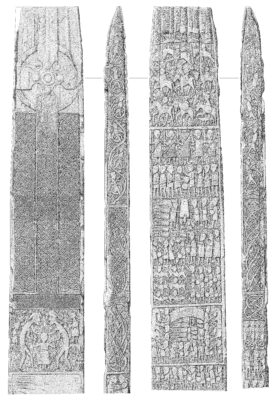All of our lectures are live streamed and are open to anyone to join us online, Fellows and Non-Fellows.
To view any of our past lectures please visit our YouTube channel.
To view any of our past lectures please visit our YouTube channel.

Battle, Ballads, Burning and the Bible: a new interpretation of ‘Sueno’s Stone’ at Forres
by Professor Jane Geddes FSA

©Historic Environment Scotland
At over 6.5m high, the cross slab at Forres is one of the largest monuments to survive in tact from the early middle ages, at least in the British Isles. It is Scotland’s Bayeux Tapestry, but 200 years older. Although named since the seventeenth century as ‘Sueno’s Stone’ after the eleventh-century Sweyn Forkbeard of Denmark, recent carbon dating by Gordon Noble places its erection in the later ninth century. Its immense height has made the carving hard to read until John Borland produced recent drawings enhanced by scrutiny of earlier plaster casts. These provide for the first time detailed evidence of the traumatic events recorded on the stone.
The monumental and resolute cross on the west face, taller than that at Gosforth, is a reminder of the enduring strength of the Christian tradition, its design reflecting later stages in Pictish art.
An enigmatic scene below the cross appears to represent a royal inauguration, often compared to the thirteenth-century seal of Scone abbey depicting the inauguration of King Alexander III. With its diminutive central figure it is unlikely to represent a king. It resembles more closely the ‘Arming of David’ before his struggle with Goliath, a composition found on the silver imperial plate of Heraklius, part of a series linking the triumphs of the Byzantine emperor to the story of young David. This parallel, albeit transformed into Pictish style, lends a biblical cast to the entire narrative, not literally but providing a moral allusion. It is a form of inauguration, preparing the hero not for kingship but for battle on the opposite face of the slab.
The military engagement on the east face includes over 80 warriors, at least sixteen beheaded. Signs of horse and possibly dog sacrifice indicate Viking funerary practice. While illustrating alien pagan ritual would be unusual on a Christian memorial, the Bible adds an overtone of damnation and the furnace of Hell. The military encounter does not read like a continuous narrative but has many similarities to the episodic nature of early battle epics like the Gododdin and the Tain, where named heroes are called out in repeating sequence. Early Welsh and Irish literature provide a soundscape to the sculpture.
It is possible the outcome ended in a truce or treaty, such as that negotiated between King Alfred and the Danish King Guthrum c. 886-890, setting out areas of mutual respect. On the side panels, two men seem to proffer books or documents to each other, while pairs of entwined mermen peacefully hold hands. Even the vine scroll, normally populated with birds and beasts symbolically nibbling the grapes, is filled with strong men grasping the eucharistic fruit, as Guthrum was persuaded to do at Wedmore in 878.
This event will be both in person at Burlington House and online. Please select the appropriate ticket below.
If you have any questions, please contact us at [email protected].